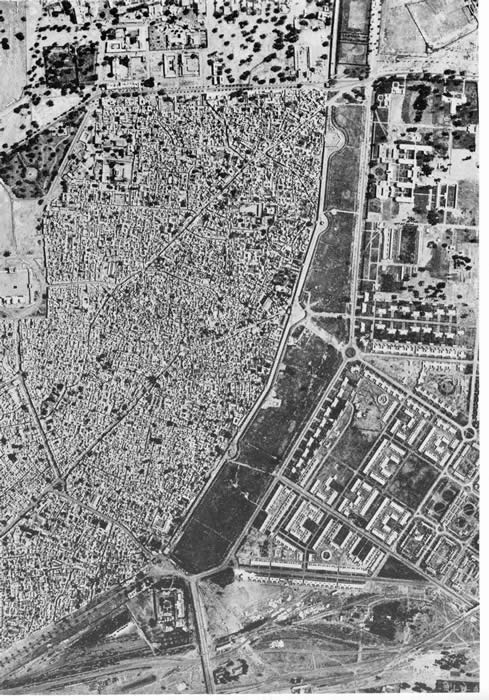|
 |
 |

| Research Interests |
| My empirical research is focused on colonial India, with Delhi as capital of the Raj (1911-47) providing the main focus. In terms of conceptual analysis I seek to contribute to the literature on Foucault, postcolonialism and memory. My research falls into four main categories with their attendant theoretical interests: |
- investigations of the means by which colonial order was imposed upon the existing city (Old Delhi) and the imperial capital (New Delhi). This work seeks to explore the spatial governmentalities by which the two cities were governed as one. Four landscapes of ordering are focused upon, the last of which has led to a separate research project on prostitution (see below). The first three interests each inform chapters in a recent book on this topic (Legg 2007a). In addition to empirical discussion, this work also reflects on the applicability of Foucault's governmentality work to colonial India, and the spatial dimensions of this work (Legg 2007d, Legg 2010).
- spatial archaeology of New Delhi's residential landscape: an investigation of colonial social categories and their spatial formations. In particular, attention is paid to the failure of the material form to embody utopian colonial hierarchies, and the spaces of resistance that the city created. Theoretically, this work builds upon Stoler's (1995) and Young's (2001) plea to consider the colonial relevance of Foucault's archaeological methodology.
- disciplining the capital region: an analysis of the policing of crime, anti-colonial nationalism and religious nationalism (communalism). Foucault's/Deleuze's concept of the "diagram" is used to explore the functioning of spatial discipline in both New and Old Delhi.
- Biopolitics and the urban environment: a study of the Delhi Improvement Trust and its attempts to deal with the over-congestion of Old Delhi, resulting from the residential shortages in New Delhi. This has allowed a series of studies which draw out the theoretical implications of this research regarding:
- Foucault's population geographies (Legg 2005a)
- Calculation (Legg 2006a)
- Biography (Legg 2008)
- Postcolonial developmentalities (Legg 2006)
|
- : international governmentalities and interwar India: research on the regulation of prostitution in 20th century colonial india. Theoretically, this work combines my previous emphasis on the politics of material spaces with a broader ranging concern for more distant scales of influence. This requires an engagement with the problematically interlocking literatures regarding networks, hierarchies and scales (Legg 2009a, 2009b). This emphatically does not entail explaining phenomenon at the scale of the international and describing them at the local. Rather, this research begins with an exploration of the regulation in Delhi and then stretches out, following archival leads from the "local" to trace the interventions of the "national" and the "international". This work is most fully expressed in my Duke University Press book (2014) which touches on the perspectives below, which each have complementary publications on associated topics
a.Civil Abandonment: Delhi's inclusive exclusion: An examination of the petitioning that led to the exclusion of prostitutes from Delhi's central bazars, and the hotly contested debate over the sites for their relocation. This is complement by a study of the voluntary organisations that emerged in the 1920s in order to tackle the problem of prostitution on behalf of the government, and include prostitutes in debates over public health and to physically "rescue" girls from brothels. The Local Administration was eventually drawn into more direct action by the passing of the Suppression of Immoral Traffic Act (SITA) in 1939.
i) 19th to 20th century (dis)continuities (Legg 2009c)
b. Networking India: from toleration to suppression of brothels A series of scandals during 1913-18 brought red light districts into disrepute and sparked a quest for a legislative solution to the problem of public prostitution. Burma and Bombay proved to be the most inventive urban laboratories. They provided the legislative blueprint for the first SITA which inspired similar legislation throughout India until independence.
i) the making of red light districts and their discreditation from 19th to 20th century (Legg 2012c)
c. Networked India: the Association for Moral and Social Hygiene She AMSH sought to spread SITAs and social hygienist doctrines throughout India from the late 1920s. It's representative, Meliscent Shephard, emerges as a tense and overworked orchestrator of international networks and a mediator of competing interests. She was eventually discredited by both the government, who suspected her of nationalist inclinations, and Indians, who suspected that she was crafting another “Mother India” report (Sinha, 2006).
i) Imperial feminism (Legg 2010)
d. Networked India: the British Social Hygiene Council and the League of Nations The British Social Hygiene Council provides a window into Britain’s attempts to come to terms with a more international, and less imperial, world than it would have preferred. The League of Nations had a tremendous impact through sponsoring international conferences and reports which fortified “trafficking” as the discursive and governmental operandi for tackling prostitution. It initially constructed brothels as a domestic affair outside of its international remit but eventually came to campaign directly for tackling the brothels of the “East”.
- Indian scalar sovereignty and the League of Nations (Legg 2009a)
- International governmentalities and the League's anti-trafficking work (Legg 2012b)
- India's internationalist anomaly (2014b)
- Subaltern figures: this project concludes with a series of reflecitons on what we can glean from the archives about subaltern experience and the articulations of subalternity within the colonial archive.
i. Examining "anti-vice" campaigns to look at how girls and women were represented in discourses about trafficking and prostitution. This takes in multi-sensory depictions of the environments of sex as well as statistical and prosopographical attempts to recount the joint experience of sexual subalterns (Legg forthcoming).
ii. Exploring the work of Gayatri Spivak in an attempt to tackle the cautions and compulsions to speak about archival and sexual subalterns. This paper considers the interdependence of more empirircal and more analytical definitions of subaltern space, and traces them through a report into some of Delhi's ashrams from the 1930s (Legg forthcoming)
|
- : this research explores local reactions to Delhi's spaces of colonialism, but also focuses on the development of anti-colonial nationalist communities and campaigns. These include organisations based around the Khilafat outrage, Gandhian non-violence, Congress Socialism, Communism, the Muslim League, Hindu Nationalism and revolutionary violence. There are several recurring tropes that emerge throughout this research:
- Embodied tactics: the Gandhian emphasis on the body as a political tool, whether of placement, dress, diet or obstruction. Such techniques shook off their political origins and were taken up socialists and communists alike.
- Violence: revolutionary, communalist and socialist groups deserted Gandhian non-violence and targeted spaces of colonialism throughout the two cities. This effectively challenged the landscaping ethos of imperialism, but also the British claim to be the sole arbiters of violence.
i. Violence and memory (Legg 2010 )
-
Scale: the articulation of different scales of activity in the city, from occasional yet mass events (Legg 2005b), through the mohalla walled communities of the old city, to the domestic scale.
- Homeplaces and the activity, rather than the representation, of women in the nationalist movement (Legg 2003, 2007c). Ongoing research on mobility, nomadism and de-territorialisations that transgress scales of political activity.
-
Scale, networks, assemblages (Legg 2009a, 2009c)
- The city as a site of movements (Legg 2014)
-
Memory: the use of social memory to solidify political communities and encourage dissent. This has been addressed from theoretical and empirical perspectives in the following publications:
-
The refusal to forget colonial violence (Legg 2005b).
-
The dangers and utility of Pierre Nora's work (Legg 2005c).
-
The value of memory work for geographers (Legg 2004, 2007).
-
Memories of violence as a form of postcolonial anamnesis (Legg 2011f)
|
- : future research which will examine Delhi in the ten years after independence. The city's response (the formation of the Delhi Master Plan) to the influx of migrants following partition from Pakistan will be analysed. This will also be in the context of attempts to de-memorialise the two cities through the removal of colonial monuments and street names. However, the retention of many aspects of Delhi's colonial geographies (residential zoning, policing strategies, abstract urban planning and the persecution of prostitutes) problematises the "break" of Independence, as do the new policies of "development" that were imported from the west to accompany the democratisation of the new state. Existing publications address:
- Some of the (dis)continuities have already been explored through the concept of "postcolonial developmentalities" (Legg 2006b)
- The relevance of the urban as a site of (dis-continuity) regarding colonial and developmental discourses (Legg and McFarlane 2008)
|
|
 |
 
|
|




